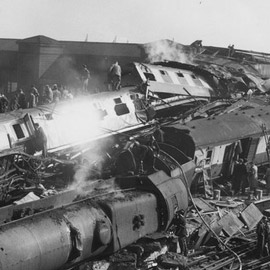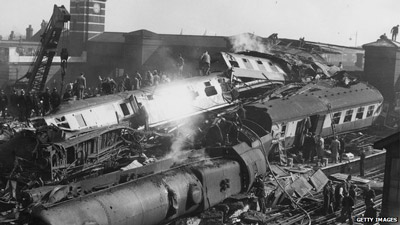I’m a human being, not a human robot
Posted: 31 March 2016 | | 3 comments
In his latest blog for Global Railway Review, Daniel Davis looks at why distraction was the cause of two rail incidents 95 years apart and discovers why human impact should be taken into account whilst highlighting measures that can be put in place rather than relying solely on new technology which in itself could be a distraction…




Henry Ford once said “If you always do what you’ve always done, you’ll always get what you’ve always got.”
During my study with the Institute of Railway Operators UK (IRO) some two years ago, I was asked to do some crucial analysis exercises on the causes of the Quintinshill rail accident in 1915 and the Moreton accident of 2010. These accidents happened some 95 years apart. As in both the Quintinshill and Moreton accidents one of the underlying reason for both accidents was ‘distraction’, either by the presence of the two guards in the signal box, as in the Quintinshill accident, or when the level crossing keeper was distracted by a telephone call from a farmer using another crossing as in the Moreton accident. It should be noted that the level crossing keeper at Moreton was described during the court case as an otherwise thorough and exemplary employee. Based on my 24 years operational expertise within the British railway industry, my first reaction pointed rightfully at the lack of modern technology, but that wasn’t all. I would like to share my conclusions with the reader and hope it is of some interest.


I strongly believe that the core route to the majority of incidents is disturbance of concentration; or perhaps I prefer to name it “becoming distracted”. This is the area where I believe we need to be looking when completing any person’s operational assessment, following which we then need to teach these operators about ways in which they can remain focussed on their task. When assessing a person’s ability to undertake a safety critical operational role, surely it requires further assessing that person’s ability to concentrate and remain focussed. One can throw all the technology in the world at the railway, but there remains one fundamental flaw in all the prevention measures: it is the risk factor human being. Wouldn’t it be better to design a bespoke competence plan to an individual driver, within the guidelines of the company policy, and then assess the person on that?
Having completed my investigation, it came as a bit of a shock and surprise to understand that it is only following an incident that such questions are asked: “What did they do over the past 36 hours?”, or: “Are they having problems at home?”. Surely with a proactive mind these are character issues that all assessments should focus on. I mention the word focus as it is that which becomes so easy to lose when we are under stress from work.
Driving trains requires us to focus on many different tasks; sometimes all occurring at the same time such as an Automatic Warning System (AWS) warning followed by a Driver Safety Device (DSD) vigilance warning and the signaller contacting you whilst being engaged in coming to a stop at a station or red signal. Train drivers are often required to multi-task, so with more and more issues to distract from the basic job of getting a train to move and stop it again in the safest possible way, are we able to mentally cope with the increasing demands to focus.
“How can we regain focus whilst working under pressure? Simple, by the means of a ‘checklist’”
We live in a world of great complexity, where even the experts can sometime struggle to master the challenges they face. So how can we regain focus whilst working under pressure? Simple, by the means of a ‘checklist’. This can be of many forms. For me this is in a form of my daily diagram. This enables me to check of stations, and cross it off once at a stand, it also enables me to make notes upon the same with regards signal aspects, or signal numbers. It helps me regain focus even if I do become distracted. It is worth mentioning that even in the most skilled professions using such simple methods has its advantages. It was back in October 1935 when the Boeing Corporation sent their most experienced test pilot Major Ployer P. Hill, on a test flight for Boeing’s model 299. However, shortly after take-off the engine stalled, the plane crashed and killed two crew members, including Major Hill. The investigation revealed that the crash was owing to “pilot’s error”. Major Hill had forgotten to release a new locking mechanism (In those days a modern piece of technology). The newspapers stated “It was too much plane for one pilot”, but as we know Boeings are still flying today. So what ensured their continuing success? A simple ‘Checklist’! Standard procedure for every present day flight.
Having done further studies and understanding basic psychology, I read once that to truly keep up concentration on listening over an extended period without becoming distracted is extremely difficult, not least very tiring. I refer to this as I will explain. Truly listening is also very different to hearing. I simply hear noises around me, someone’s voice, mixed with music or noise from the outside environment. We become easily distracted by things around that are of interest. These distract us and can cause loss of focus on what we are doing or about to do. I once stood watching and listening to crowds whilst awaiting my train on a busy platform. I noticed that if two or more people were engaged in conversation with each other, on hearing the ring of a phone or the sound of an incoming email or text, they immediately appeared to become distracted from the conversation and pick up their phones to have a look. Even when it wasn’t their own phone making the noise! This alerted me to a clear observation: modern technology is available to reduce incidents and accidents, but it also furthers distraction. How can we reduce this? This is what I believe we should now focus on.
“It is better to understand our employees as individuals”
Whilst I strongly believe we need guidelines and rules, surely it is better to understand our employees as individuals. We are then better placed to train and develop them in the specialist role we need them in and then work on removing or reducing distractions in their working environment. Thus reducing or eliminating the risk of an operational incident or accident!
I became inspired by railway history, also rail accidents after reading Peter Vandermark book titled ‘Level Crossings with Stanley Hall’ also having a seek preview of Peter’s Upcoming book titled ‘An Unexpected End of the Journey’ available at the end of July 16′ I owe my newly found knowledge and experience down to this amazing railway/transportation expert.
Global Railway Review Autumn/ Winter Issue 2025
Welcome to 2025’s Autumn/ Winter issue of Global Railway Review!
The dynamism of our sector has never been more apparent, driven by technological leaps, evolving societal demands, and an urgent global imperative for sustainable solutions.
>>> Read the issue in full now! <<<









Very good piece, even if it does re-iterate many things that have been known, admitted to, and worked on in the industry for many years. I do however really support your contention that the current driver training programme, and the post qualification sterile period does incubate problems for later on.
As someone who passed for Driving under BR in 1983, I ‘grew up’ in the line of promotion in an atmosphere of 2 or 3 men in the cab as routine, and usually, this often meant one 3 way conversation taking place many times through the shift.
This was a good training mechanism to learn the skill of what I later discovered was called situational awareness – the ability to multi-task but stay focused on the task in hand. This was part of the then locomans training and upbringing, and is a skill that has to be learnt. One, if not THE critical underlying factor behind outlawing the use of using handheld mobile phones in cars is the fact that the majority of car drivers have little or no situational awareness and in such a position will shift their attention focus to the conversation, from driving the car, hence accidents happen. By default, the same must now apply to many train drivers who have largely only ever known single cab occupancy. They have never known or worked in a ‘busy’ cab environment and the first few times it occurs, is it a big assumption that an error will be made because they are distracted? I dont think it is, but certainly I feel the risk is.
Some years later when I was at RT then NR i would frequently ride with drivers of my seniority, who were quite often very pleased to have someone in the cab with them to break, as one driver put it, ” the mind-numbing bloody monotony”. Undoubtedly many drivers have become used to their solitary existence, and another interesting facet in one of the other comments re the radio; when first setting out the spec for EWS’ intended initial class 66 purchase, it was decided that the ‘standard fit’ FM radio was to be deleted as it was felt that HMRI would not approve. Sadly, as i remember, we never asked them, so we will never know whether such might of actually improved concentration – how many of us drive cars without the radio or music playing – i suspect not many.
During a discussion at an NSFG meeting I threw these thoughts into open discussion and suggested that the desired safety improvements were not going to be forthcoming as ‘we’ were replacing one problem with another and that a reduced, simplified regime of in cab experience be included as part of early training for anyone coming into the LoP, I was roundly criticised by several, including one senior FGW manager, who rather curtly informed me that I didnt know what I was talking about! The point I was trying to make was that a crucial aspect of training was being discarded. Sadly the failure to heed past mistakes and repeat them, can be as bad as sticking to a ill judged unproven course as per your Henry Ford quote does seem to be quite prevalent.
I agree with the analysis of cause but feel that the control measures risk exacerbating the problem. Current thinking seems to be “we’ll remove distraction risk by removing all potential sources of distraction”. Therefore, the Guard may not enter the cab, mobile phones are not permitted et al.
However, this then makes the task very isolated and monotonous and to my mind increases the risk of distraction as the brain seeks something to stimulate it whether now is a good time or not!
To me, it would be better to train Drivers to manage distraction better but then to permit some under controlled conditions. Such matters as the Guard wishing to converse cause a decent Driver to do a quick and ongoing dynamic risk assessment which I believe re-engages them with the task consciously and disengages the mental auto pilot.
I recall an experiment whereby Australian railways fitted radios (the entertainment kind) in cab with appropriate controls to limit volume, emergency call cut out etc and found their SPAD rate fell. Supporting evidence to my argument I feel.
I appreciate the real rationale behind current thinking is reduction of risk of corporate liability but if the issue is to be seriously addressed then a more mature and less simplistic approach may be indicated.
Good article; as you note employers and managers should have simple effective check lists for intercepting unsafe behaviours or unsafe conditions (distractions) that might lead to human error (slips, lapses etc) and incidents.
Going further its important to educate and train employees on how to observe distractions and stress and the impacts of this to their working behaviours and role execution.
Prioritising training towards employees who carry out critical safety roles such as drivers, machine operators etc so that we are helping where we can to improve their ability to self diagnose when they are stressed and when their concentration is being affected before the impact of an accident.
The challenge with this is that self diagnosing when you are stressed or suffering too many distractions at work is if we are being honest, an area we all struggle with from time to time.
Human tendency often will follow a common pattern; failure to spot symptoms first, deny or ignore symptoms second, suffer symptoms without action third…. and its within any of those behavioural stages that the concentration lapses and slip errors can occur resulting in the accident.